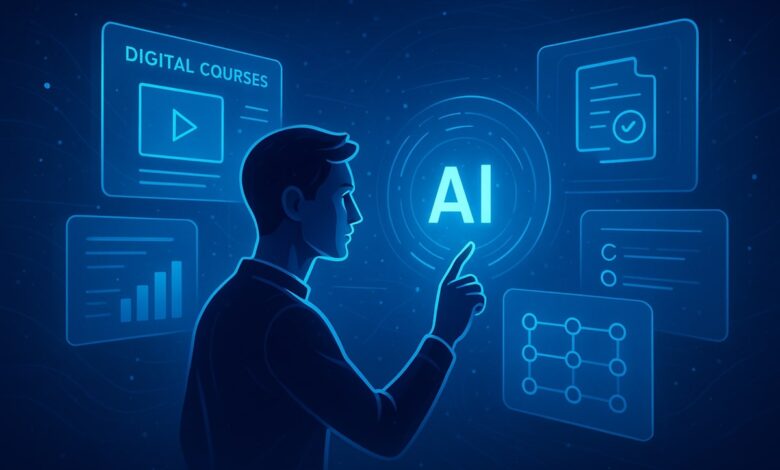Master New Skills Faster Using AI Resources for Learning and Growth

Learning new skills can feel overwhelming. There’s so much information online, so many courses and tutorials, and it’s easy to get lost in it all. That’s where modern technology comes in.
Today, AI resources for self-improvement and learning are helping people figure out what to focus on, track their progress, and pick up new skills faster. These tools make it easier to learn efficiently, study smarter, and develop skills at your own pace.
Whether you want to improve professionally, learn a new language, or pick up a creative hobby, the right resources can save time and make learning more effective.
How Technology is Changing the Way We Learn

The traditional “one-size-fits-all” approach to learning doesn’t always work. Some people grasp concepts quickly, while others need more practice.
Modern learning tools adjust to your pace and focus on your weak areas. This personalized approach ensures you spend time where it matters most.
For example, imagine you’re learning graphic design. Instead of completing every single tutorial, a smart learning tool can identify which areas you struggle with – like typography or color theory – and suggest exercises to strengthen those skills. This way, you’re not wasting time on lessons you already understand.
These platforms can also help you stay motivated. By tracking your progress, providing reminders, and offering interactive exercises, they create a learning experience that keeps you engaged.
Useful Tools to Improve Skills Faster
1. Digital Tutors

Some platforms act like personal tutors. They guide you through challenging topics, provide explanations, and even simulate real-world scenarios.
For instance, if you’re learning a new language, a digital tutor can ask questions, correct mistakes, and suggest exercises based on your current level.
Digital tutors are helpful because they provide support similar to having a teacher beside you. You get feedback when you need it and guidance tailored to your needs, which speeds up learning and prevents frustration.
2. Personalized Learning Platforms
Personalized learning platforms adjust lessons based on what you already know and what you need to improve. As you complete exercises, the platform identifies your strengths and weaknesses and suggests the next step.
This approach works well for complex subjects, such as coding, data analysis, or business skills. Instead of moving linearly through a course, you focus on what you need most. Over time, this makes skill-building more efficient and less overwhelming.
3. Curated Learning Content

One of the biggest challenges in self-learning is knowing where to start. Some platforms offer curated content, recommending articles, videos, and exercises that match your interests and goals.
For example, if you’re learning digital marketing, the platform can suggest the most relevant tutorials on SEO, social media advertising, or email campaigns. This eliminates guesswork and ensures that your learning time is productive.
4. Progress Tracking
Understanding where you stand is crucial for improvement. Modern tools allow you to track your progress, measure your strengths, and identify areas that need more attention.
By reviewing your performance regularly, you can adjust your learning strategy and focus on what will give the best results.
Tracking your progress also helps maintain motivation. Seeing tangible improvements reinforces the effort you put in and encourages you to continue learning.
Benefits of Using Modern Learning Tools

Using these resources has several clear benefits:
- Learn Faster: Focus only on what you need most, rather than wasting time on areas you already know.
- Better Retention: Interactive exercises, quizzes, and repeated practice help information stick.
- Flexible Learning: Study at your own pace, anywhere and anytime, without relying on a fixed classroom schedule.
- Increased Motivation: Tracking your progress and receiving regular feedback keeps you engaged.
In addition, these tools often provide community features, allowing learners to share experiences, ask questions, and collaborate. This sense of connection makes learning feel less isolating and more enjoyable.
Practical Tips for Making the Most of Learning Tools

Even the best resources won’t help if you don’t use them effectively. Here are some tips to maximize your results:
- Set Clear Goals: Know what skill you want to acquire and what level you hope to reach. Clear goals help you stay focused and measure your progress.
- Mix Tools: Combine different resources for a balanced learning experience. For example, use a digital tutor for guidance, curated content for depth, and progress trackers to measure improvement.
- Create a Routine: Consistency is key. Schedule regular learning sessions, even if they are short, to make steady progress.
- Practice Actively: Apply what you learn in real-world scenarios. If you’re learning coding, build small projects. If you’re learning a language, practice speaking with others.
- Review and Adjust: Use progress tracking features to identify gaps and adjust your learning plan accordingly. Focus on areas where you’re struggling most.
Looking Ahead: The Future of Learning
Learning is becoming more practical, interactive, and personalized. As these resources continue to improve, it will be easier than ever to acquire new skills quickly. Virtual classrooms, interactive exercises, and personalized guidance are becoming standard features.
By embracing these tools today, you can grow faster, stay motivated, and make the most of every learning opportunity. The key is to be consistent, stay curious, and use these resources to guide your learning journey.
Whether you’re improving professionally or picking up a personal hobby, modern learning tools make it possible to learn smarter, not harder – and master new skills faster than ever before.



